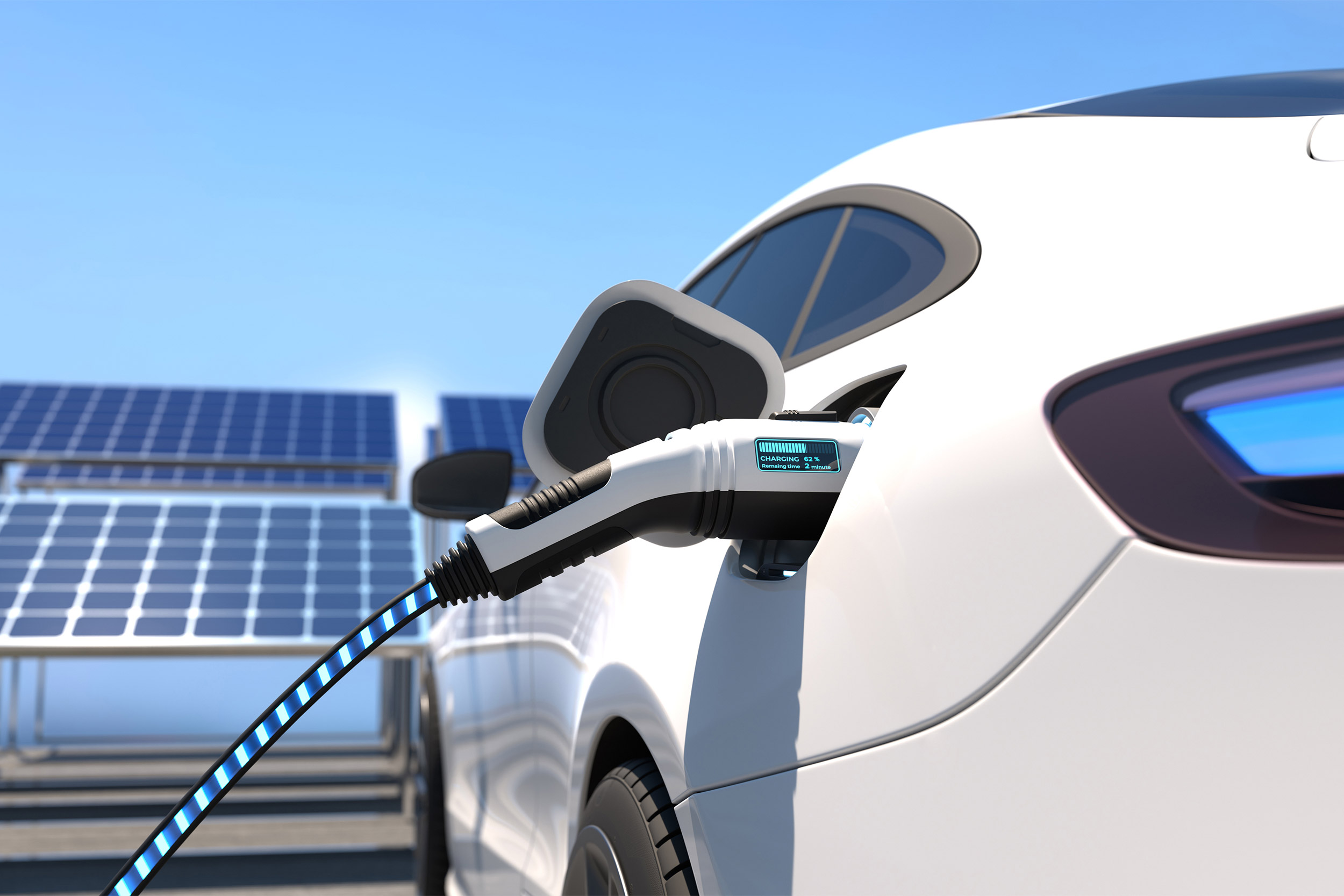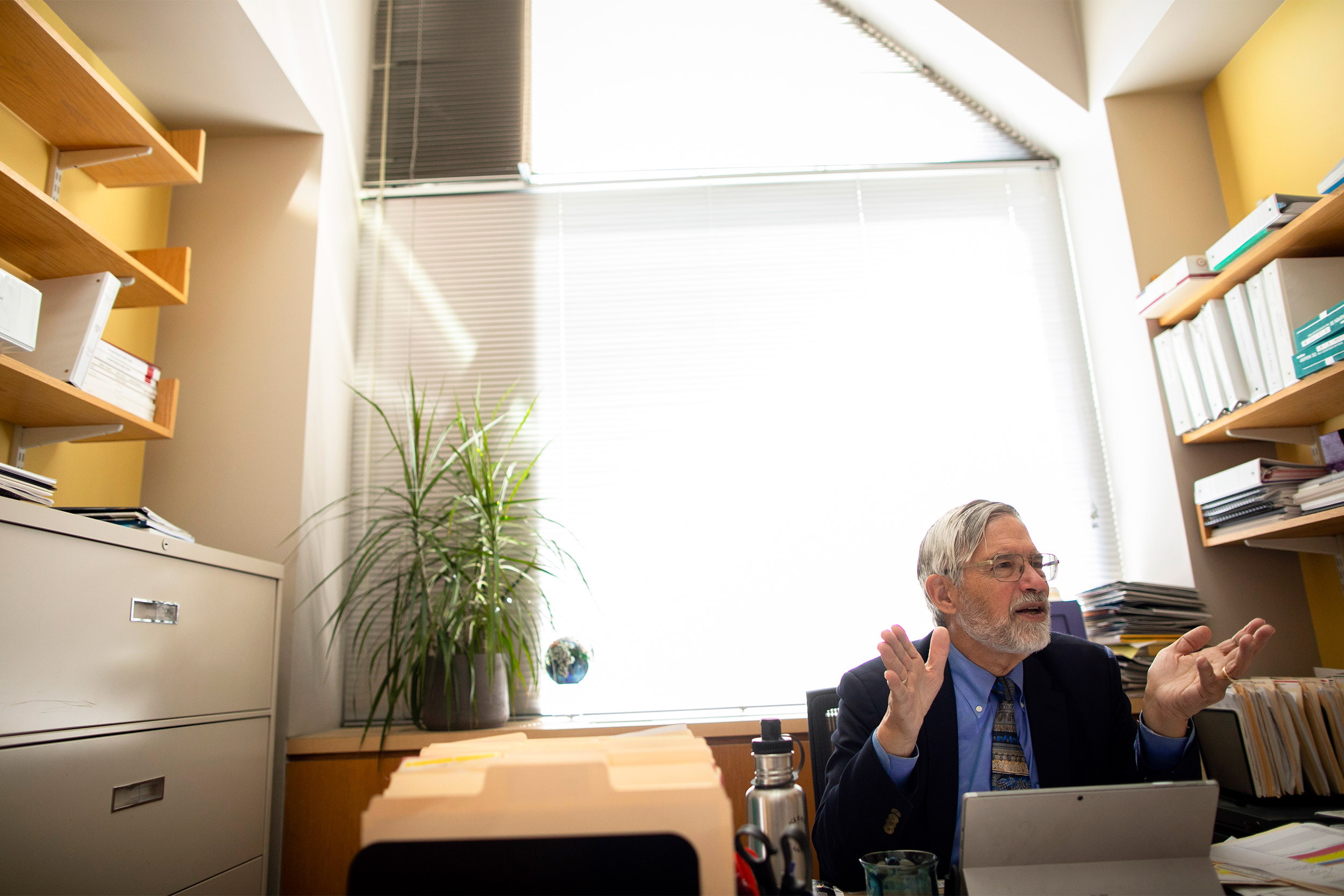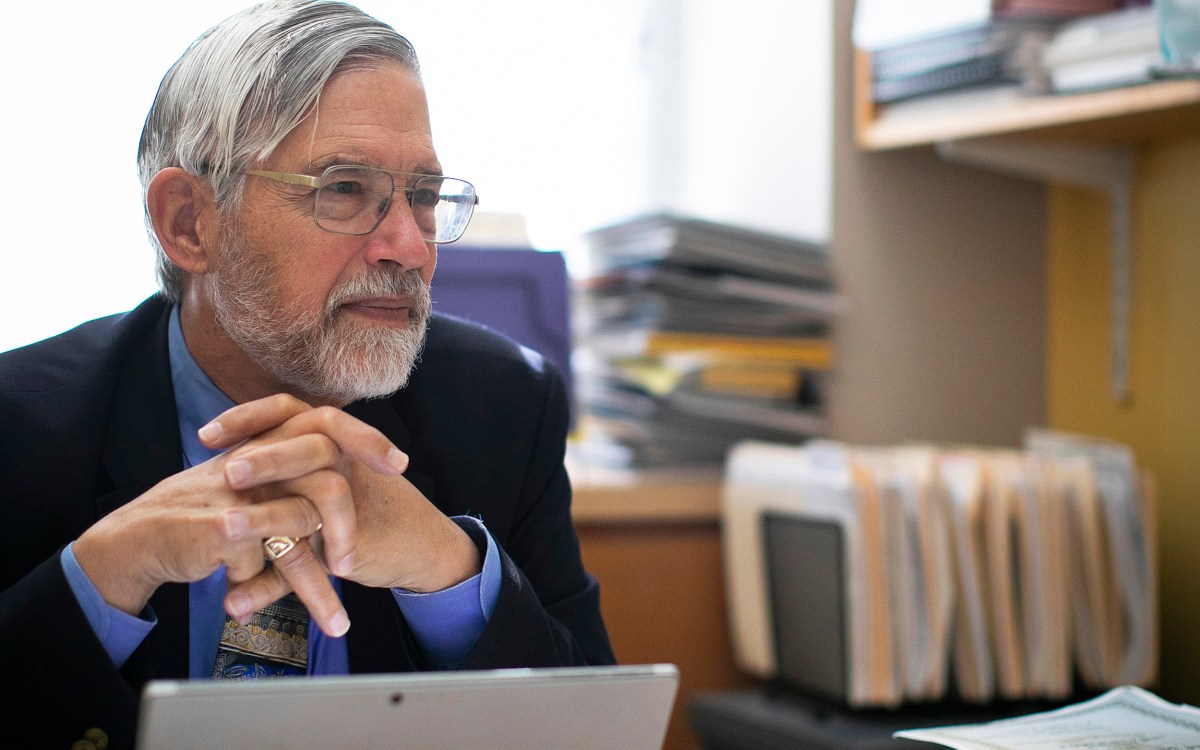
A tax credit to consumers for buying electric vehicles is among the proposals in the $369 billion package that would boost climate change responses and energy security.
iStock by Getty Images
Finding much to like in Senate climate deal
Environmental policy expert sifts details, estimates plan will yield real, significant emission reductions
The Senate passed a historic climate, health, and tax bill after marathon negotiations over the weekend, talks made possible by a sudden agreement last month between Democratic Majority Leader Chuck Schumer and hold-out Sen. Joe Manchin of West Virginia. The two agreed to a package that would spend billions to boost climate change responses and make other tax and revenue changes that would more than pay for the spending over time. The proposal’s supporters say it would spend $369 billion on climate change and energy security, while the nonprofit Committee for a Responsible Federal Budget puts the number at $385 billion. The Gazette spoke with John Holdren, who served as President Obama’s top adviser on science and technology policy and currently is the Teresa and John Heinz Research Professor of Environmental Policy at the Harvard Kennedy School, about the legislation and its potential impact. The House is expected to take up the bill later this week and send it to President Biden for signing. The interview, conducted before the weekend’s Senate action, was edited for clarity and length.
Q&A
John Holdren
GAZETTE: This proposed legislation seemed to surprise a lot of people when it was announced late last month. Did it surprise you?
HOLDREN: Yes. Like most people, I thought when Manchin declared it dead only a few days earlier, it really was dead. I was very gloomy about it, and everybody I know was very gloomy about it. But somehow Schumer and Manchin figured out a way to rescue it, and they rescued a lot of important stuff. They didn’t get agreement on everything that matters, but what we got — assuming this is actually passed and signed into law — would be a whole lot better than nothing.
Apparently, the key with Manchin was a combination of measures to avoid an inflationary hit from expenditures on clean energy and climate change and some agreements mandating a certain amount of leasing on federal lands for oil and gas. While it’s disappointing to some of the environmental groups and many environmentalists that that was the price, a lot of us believe it will be much less impactful than the investments in clean and efficient energy. Not a bad deal, is my conclusion.
GAZETTE: I’ve seen some saying this would be the strongest climate legislation ever passed at the federal level. Do you agree?
HOLDREN: I think that’s right. There have been a number of assessments published — not just by the bill’s authors — suggesting that this could be enough to get us to 40 percent below 2005 emissions by 2030. That’s not quite as far as the 50 percent Biden promised, but it’s also not 2030 yet, and this could be more than a good start on additional measures that might get us the rest of the way. I say that without believing that any particular numerical target is the key to salvation. We are already experiencing, at about 1.2 degrees Celsius above preindustrial temperatures, devastating droughts, wildfires, torrential downpours and floods, more powerful storms, expanding ranges of tropical diseases, and more. The climate change problem is already upon us, and there’s no silver bullet that’s going to make it all go away. We have to aim for increasingly effective measures to reduce emissions by a very large margin. And 40 percent below 2005 emissions levels by 2030 would not be bad — not good enough, but this measure may stimulate some follow-ons, particularly once some of its provisions are seen to be succeeding.
GAZETTE: There are a lot of incentives aimed at consumers in the legislation, with tax credits for energy efficiency and electric cars. Does it take largely a bottom-up approach or is it more balanced than that?
HOLDREN: I think it’s more balanced. It’s both bottom-up and top-down. I’ve always thought that comprehensive programs on almost anything significant — and difficult — need to be a combination of bottom-up and top-down. This looks to me like a pretty good balance. There are important things missing that were in the other measures the Biden administration was trying to get through, but there were also some not-so-good elements in there that have been dropped. I don’t argue that this is an ideal piece of legislation, but it is so much more than we thought we were going to get.
“The single most important thing that’s left out — under current political circumstances, there was just no way it was going to get done — is putting a price on carbon emissions across the board,” said John Holdren.
File photo by Stephanie Mitchell/Harvard Staff Photographer

GAZETTE: Are there specifics in there that you like in particular? That may have multiplier effects?
HOLDREN: The energy and climate total, $385 billion, is terrific. The clean-manufacturing tax credits represent a very productive approach. The tax credits to consumers for buying electric vehicles and energy-efficiency improvements, too. We know that those work. The real name of the game in getting emissions under control is making the clean options more attractive economically than the dirty options. It’s that simple. So any measure that can contribute to creating or expanding the economic advantage of going with clean and efficient technologies is a smart thing to do, and there’s a lot of that in here.
There are also some specifics, like very substantial incentives to companies for reducing methane emissions, that are a big deal. Some of the measures focused on offsetting the economic costs are also very good. There is always an emphasis on how much it’s going to cost to have cleaner options faster, but there is almost never a discussion of how much money those measures will ultimately save the economy through reduced damages from climate change. I wish there was more attention paid to the economic benefits of taking these steps. Our late, great economics Professor Dale Jorgenson, who died recently, was a great exponent of the proposition that doing what we need to do to address climate change would ultimately be an economic benefit, not a cost.
GAZETTE: Looking at cost, will we eventually reach a tipping point after which renewables will be cheap enough that they’ll spread on their own, like natural gas did when it undercut coal? Is it possible that this legislation can get us to that tipping point?
HOLDREN: In some respects, we’ve gotten to that point already. Electricity generation from solar photovoltaics and from wind power in many places is now cheaper than electricity generation with coal. And in some places, it’s cheaper than electricity generation with natural gas. That’s a very important driver. One of the challenges is that some technologies that we need to embrace if we’re going to get emissions reductions down as much as we need to are more obstinate economically. I’m thinking of carbon capture, sequestration, and utilization, for example.
Some environmentalists hate those options, saying it’s just a further lease on life for fossil fuels. But in a world that is still almost 80 percent dependent for its primary energy on coal, oil, and natural gas, we have to recognize that there is going to be quite a lot of fossil fuel burned in the years ahead. What we need to do, given the urgency of the climate change challenge, is make it possible to burn some of that fossil fuel in ways that do not release the resulting carbon dioxide into the atmosphere. But carbon capture and sequestration of that carbon in geologic formations is intrinsically expensive, and we will do it only if it is made more economical with subsidies from the government or regulations. So that is another good characteristic of this new legislation: It would provide a boost to the subsidies for carbon capture and sequestration.
GAZETTE: Might supporting carbon capture and sequestration tell oil companies that they have a place in a future carbon-free economy and bring them on board, or is there little chance of them doing anything other than fighting this tooth and nail?
HOLDREN: The situation with the big oil and gas companies has been changing. Some of them are now very progressive in their approach to this problem. BP, for example, has completely restructured its business plan and is aiming for major reductions in the emissions of their operations, and ultimately the emissions for which they’re responsible. I’m quite sure they’re serious about it. A number of the other big oil and gas companies are moving in that direction. I’ve been saying for decades that we’re not going to solve climate change over the dead bodies of private sector companies. We’re going to solve the problem by finding ways to bring those companies on board in a pathway toward a much more sustainable energy system. Those folks can also do arithmetic — in fact they’re very good at it. They can read the data, and the data on climate change make clear that it’s real, it’s deadly, it’s here. And if we are to at least minimize the worst consequences of climate change, there’s going to have to be a much bigger transition than oil and gas companies until recently were willing to acknowledge. They’re acknowledging it now and trying to figure out how to do it. We should push them along.
More like this
GAZETTE: There are tax credits to encourage energy production, including large plants of solar and wind power. Does the legislation do anything to encourage the transmission lines needed to get the power from the places where the wind blows and the sun shines to the big cities?
HOLDREN: The biggest problem with transmission is the permitting. It’s incredibly complex to build a transmission line anywhere because of the number of permits required and the ability of any one of those permit grantors to refuse and to block the project. There is language in this legislation about accelerating and streamlining the permitting processes, and that’s going to be important if it can succeed. But this is a very difficult nut to crack because of people’s affection for due process and for review at various levels. That makes it very difficult to solve the transmission problem. It’s clear that a key to a higher proportion of renewable energy in our national mix is being able to build expanded transmission networks to get the energy from where it’s most economically generated to the places where the largest consumption is taking place. We really do have to master the transmission siting challenges in this country, or we’re cooked.
GAZETTE: What’s left out? How do we get the extra 10 percent emissions reduction that Biden wants?
HOLDREN: The single most important thing that’s left out — under current political circumstances, there was just no way it was going to get done — is putting a price on carbon emissions across the board. That could be done either with a carbon tax or with a cap-and-trade approach, as was tried initially in the Waxman-Markey bill that failed in the beginning of the Obama administration. Economists of every political stripe, conservatives as well as progressives, will tell you that the single most important and efficient thing we could do to reduce greenhouse gas emissions is to put a price on carbon emissions and let the market figure out the cheapest way to get it done.
In the Obama administration, we did calculations that said if we could have imposed a mere $30 a ton tax on carbon dioxide emissions in 2015, that the reductions by 2025 could have been 32 to 34 percent instead of the 26 to 28 percent target we embraced based on measures that didn’t include a carbon tax or its equivalent. That’s a big difference from a very low carbon tax. If we had a carbon tax of a $75 a ton or $100 a ton, it would be transformative. You could rebate the money to poor and middle-class families. You could spend some of the money to reduce other taxes. The late Dale Jorgenson showed that if you had a carbon tax and if you offset its economic impact by reducing capital gains taxes and income taxes, the economy would be better off after 20 years of having a carbon tax than without it. It’s a very old economic principle that it is more efficient in the societal sense to tax “bads” than to tax “goods.” Capital gains and income are goods and emissions are bad. If we taxed emissions instead of income and made it revenue-neutral overall, as Jorgensen pointed out a couple of decades ago or more, the economy comes out better.
GAZETTE: It seems that the power of that versus the targeted approach is that the tax is economy-wide, so it’s gaining efficiencies in every nook and cranny.
HOLDREN: And it brings out ingenuity in every nook and cranny. That’s the beauty of it.









